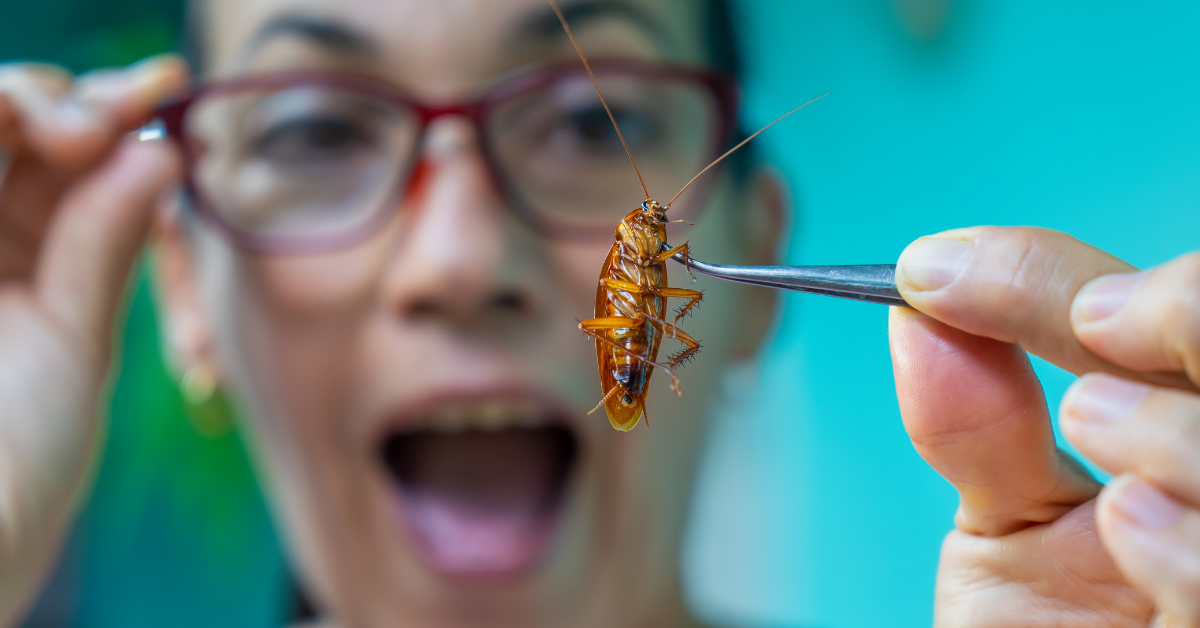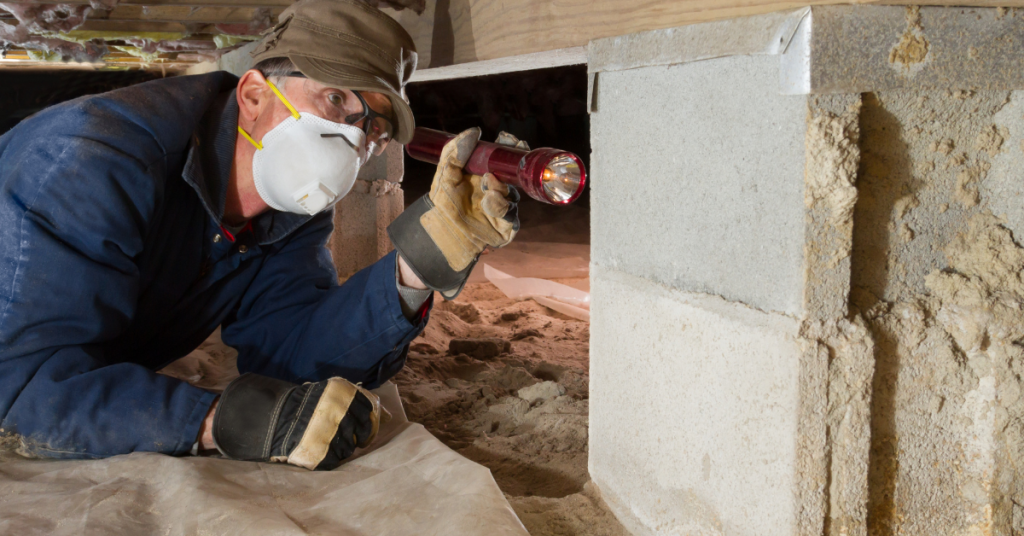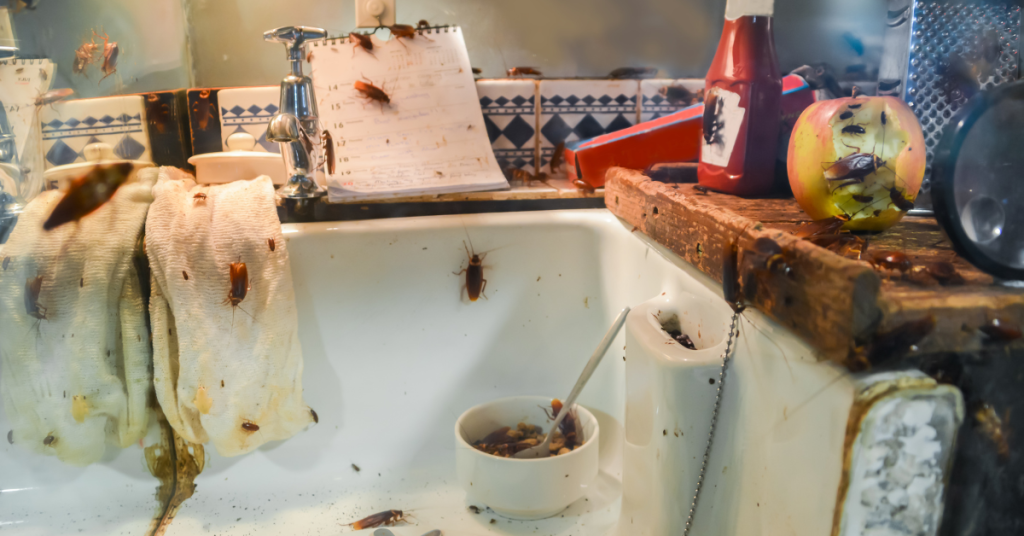
Unveiling the Secrets of the Nocturnal Roach
At Sentry Exterminating, we believe it’s essential to understand why roaches come out at night. This knowledge is a fundamental aspect of our approach to roach control, enabling us to effectively tackle any cockroach infestation that may arise. Let’s shed light on this mysterious aspect of their behavior and explore the reasons behind their nighttime activity.

A Legacy of Excellence in Roach Control
For over 50 years, Sentry Exterminating has been a leading expert in effectively dealing with roach infestations. Our extensive experience has provided us with a deep understanding of roach behavior and infestation patterns. Throughout the years, we have honed our strategies and perfected our techniques to deliver top-notch pest control solutions. With a proven track record of success, our dedicated team remains committed to providing exceptional service and keeping homes roach-free for countless satisfied customers.
The Circadian Rhythm and Nocturnal Behavior
Roaches, like many nocturnal animals, follow a circadian rhythm, which means their sleep-wake cycle is primarily active during nighttime hours. Their light-sensitive cells in the antennae help them navigate effectively in the dark, making them more active when the sun sets and darkness covers the land.

Reasons for Nighttime Roach Activity
The dark offers roaches protection and a sense of safety from predators and humans alike. During the cover of darkness, they can crawl around undisturbed, increasing their chances of finding food and water sources without the threat of being noticed or attacked.

The Role of Artificial Light
Bright lights, especially during the nighttime, can disrupt their natural behavior and make them more cautious, causing them to retreat to their hiding places. This aversion to artificial light is why you might encounter roaches scurrying away when you switch on the kitchen light in the middle of the night.
Roach Species and Their Nocturnal Behavior
Roaches are a diverse group of insects, and various species have adapted to inhabit a wide range of environments. Despite these differences, one trait unites them all—their nocturnal nature. Among the most common roach species encountered in urban and residential settings are the German cockroaches, American cockroaches, Oriental cockroaches, and wood cockroaches. Regardless of their habitat or location, these roaches share a preference for darkness and exhibit similar behaviors when it comes to their daily routines.
1. German Cockroaches:
German cockroaches (Blattella germanica) are notorious for infesting kitchens, bathrooms, and other areas with easy access to food and moisture. During the day, these small, light-brown insects conceal themselves in cracks, crevices, and the tiniest of spaces. However, as soon as night falls, they emerge from their hiding spots, lured by the scent of food and water. Their nocturnal activity and rapid reproduction make them one of the most challenging roach species to control.
2. American Cockroaches:
American cockroaches (Periplaneta americana) are larger than their German counterparts and prefer damp, humid environments. Often found in sewer systems, basements, and crawl spaces, they spend their daylight hours sheltered from light and human activity. But as darkness blankets the surroundings, they venture out in search of decaying organic matter and anything edible. Their size and ability to fly add to the challenges of managing their infestations.
3. Oriental Cockroaches:
Oriental cockroaches (Blatta orientalis) are dark-colored roaches commonly found in cool and damp locations such as basements, crawl spaces, and garbage areas. They have a strong affinity for organic matter and can survive in less favorable conditions compared to other roach species. During the day, they prefer to stay hidden and emerge at night to scavenge for food and water. While they are not water bugs, their presence in moist areas may lead to confusion with water bugs or black beetles.
4. Wood Cockroaches:
Wood cockroaches (Parcoblatta spp.) are outdoor-dwelling roach species that commonly inhabit wooded areas and grass lawns. Unlike their indoor counterparts, they do not infest human living spaces. These roaches prefer to remain hidden under logs, leaves, and debris during the day. At night, they actively forage for food in their natural habitat, making them less likely to be a nuisance in households.
Understanding the nocturnal behavior of different roach species is crucial for effective pest control. At Sentry Exterminating, our seasoned experts possess in-depth knowledge of these distinct behaviors, enabling us to tailor our solutions to tackle specific roach infestations with precision. From identifying their hiding places to implementing targeted treatments, we are dedicated to keeping homes and businesses free from the clutches of roach invasions.

Seeking Hiding Places and Food Sources
One of the main reasons roaches venture out during the night is to search for food. These crafty pests are skilled at finding organic matter that serves as their primary food source. With human food, pet food bowls, and even trash bins available in abundance during the day, nighttime becomes the perfect cover for them to explore and feast.

Humid and Warm Areas – Roach Haven
Roaches thrive in humid conditions and prefer warm areas, which are often more prevalent during the night. Hence, humid environments such as kitchens, leaky pipes, and sewer systems attract them to come out and explore their surroundings during the late hours.
Reproduction and High Breeding Rates
Roaches have a high breeding rate, and nighttime provides them with a less active and more undisturbed environment for mating and laying eggs. This contributes to the rapid growth of the cockroach population, making infestations even more challenging to control.

Our Roach Control Process
At Sentry Exterminating, we have developed a comprehensive roach control process based on decades of experience and a deep understanding of roach behavior. Our approach is designed to efficiently and effectively eradicate roach infestations, providing you with a roach-free environment. Here’s an overview of our tried-and-tested roach control process:
1. Thorough Inspection:
The first step in our roach control process is conducting a thorough inspection of your property. Our skilled technicians meticulously examine all areas susceptible to roach infestations, including kitchens, bathrooms, basements, and other hiding places. This detailed inspection allows us to identify the roach species present, the extent of the infestation, and the factors contributing to their presence.
2. Customized Treatment Plan:
Based on the findings from the inspection, we create a customized treatment plan tailored to your specific roach infestation. Our approach considers the roach species, the severity of the infestation, and any unique factors related to your property. We believe that a targeted and individualized strategy is the key to successful roach control.
3. Integrated Pest Management (IPM) Techniques:
At Sentry Exterminating, we are strong advocates of Integrated Pest Management (IPM) techniques. Our roach control process integrates a combination of methods, including the use of chemical treatments, baits, and insect growth regulators. We strategically apply these measures to disrupt roach breeding cycles, eliminate existing populations, and prevent future infestations.
4. Elimination of Hiding Places:
A crucial aspect of our roach control process involves sealing off potential hiding places and entry points. We use silicone-based sealants to close gaps, cracks, and crevices that roaches use as shelters. By eliminating their hiding spots, we limit their ability to breed and thrive within your living spaces.
5. Education and Prevention:
As part of our commitment to customer satisfaction, we provide valuable education on roach prevention. Our experts offer practical tips and recommendations to help you maintain a roach-free environment in the long term. Simple practices like proper food storage, regular cleaning, and reducing excess moisture can significantly reduce the risk of future roach infestations.
6. Follow-Up and Monitoring:
Our dedication to effective roach control doesn’t end with the initial treatment. We understand the importance of follow-up and ongoing monitoring. Our team will schedule regular inspections to ensure that the infestation has been fully eradicated, and if necessary, we will implement additional measures to maintain a roach-free environment.
7. Safe and Environmentally-Friendly Solutions:
At Sentry Exterminating, we prioritize the safety of our customers and the environment. Our roach control process utilizes safe and environmentally-friendly solutions, minimizing any potential risks to your family, pets, or surrounding ecosystems.
With Sentry Exterminating’s proven roach control process, you can trust that your home or business will be safeguarded from these resilient pests. Our expertise, dedication, and commitment to excellence ensure that your roach infestation will be handled with the utmost care and efficiency, leaving you with a pest-free living space and peace of mind.

The Good News – Prevention and Control
While roach infestations can be challenging, prevention is the first step in controlling their population. Keeping kitchens clean, fixing leaky pipes, and storing food properly can help limit their access to essential resources. Additionally, using essential oils like peppermint oil and maintaining a well-lit environment can deter these pests from invading your space.

Health Risks and Allergic Reactions
Roaches aren’t just a nuisance; they also pose health risks to humans. Their presence can exacerbate asthma symptoms and trigger allergic reactions in susceptible individuals. Therefore, addressing a cockroach problem promptly is crucial for the well-being of all living beings in your home.
Contact Sentry Exterminating for Professional Help
In a worst-case scenario of a severe infestation, don’t hesitate to seek help from pest control specialists like Sentry Exterminating. We have the expertise and knowledge to tackle even the most challenging cockroach populations, ensuring your home remains a roach-free zone.

Embracing the Night – No More Roach Woes
Now that we’ve unraveled the mystery of why roaches come out at night, you can be better prepared to combat any potential infestation. With Sentry Exterminating by your side, you can rest easy knowing that our expert team is dedicated to keeping your home free from these nocturnal pests.
